by Jeffrey
Herman
(click on photos to enlarge image)
A GORHAM STERLING MATCH SAFE RESTORED USING PULSE ARC
WELDER
As any silversmith knows, silver solder is
the ideal material to use when joining sterling
pieces by the traditional method of brazing.
Sometimes I will receive an object which has
been lead-soldered in the area in need of repair
(or re-repair).
Sometimes the joined area is not visually
accessible, and I don't know if lead has been
used.
In either case, I cannot use silver solder
because the high temperature required will melt
any lead in the joint and allow it to form its
own alloy with the silver. Not pretty! And,
using a low temperature tin/silver solder won't
give me a sound joint or good silver color.
For this reason, I use the German-made Lampert
PUK 3s Professional Plus pulse arc welder. Pulse
arc welding allows me to use solid sterling wire
for a perfect color match (silver solders
contain less fine silver than sterling).
Argon gas is pumped through the handpiece and
engulfs the welding area with a protective
atmosphere to eliminate firestain. The heat is
so localized that I can handle the object
without getting burned.
|
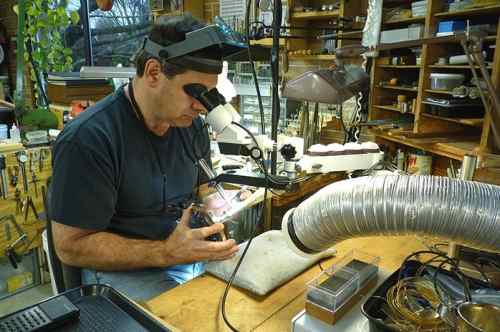
|
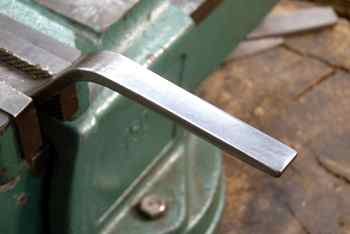
|
Restoration on this 19th century Gorham
match safe started with this steel burnisher.
This isn't a specialized silversmithing tool –
it's a modified and polished mason's jointer.
|
Positioned for burnishing.
|
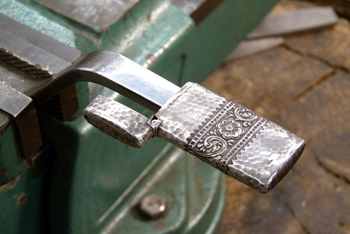
|
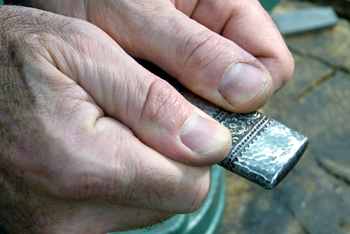
|
I apply pressure on both sides of the safe's
body, raising the dent.
|
Reforming the cover.
|
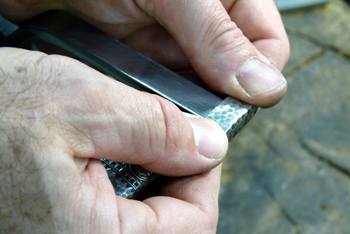
|
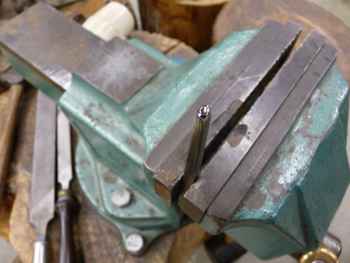
|
I used a chasing tool to remove a cover
dent.
|
The dent was removed by pushing the cover
down on the tool, rubbing it back and forth,
raising the metal. Lighting is very important,
especially in this area of the workshop. The
four-foot florescent tubes overhead give me a
perfectly straight reflection, highlighting any
imperfections appearing on the object I'm
working on.
|
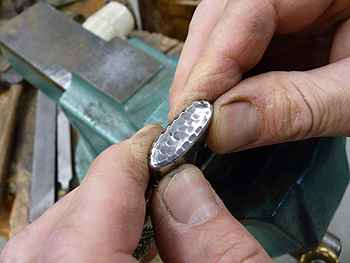
|
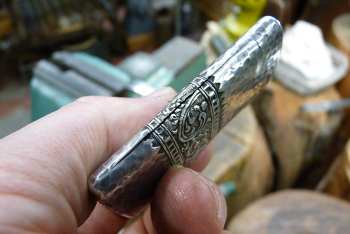
|
The most tedious repair on this safe was
closing the seam (or joint). The first order of
business was to open the seam to remove any
solder. Ultra-fine 0000 steel wool was used
inside to remove any grime around the seam,
making the surface smooth for burnishing.
|
This is another modified burnisher. Metal
burnishers are generally highly polished to
allow their surfaces to glide smoothly along the
object. Burnishing is the least invasive
technique in removing dents. Virtually any
material can be used as a burnisher, including
stone, plastic, and wood, providing its surface
is smooth. I have even ground down and polished
steel files for this purpose!
|
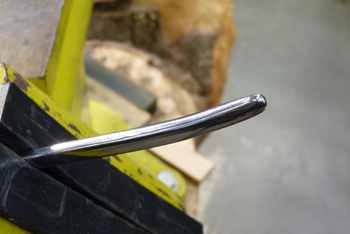
|
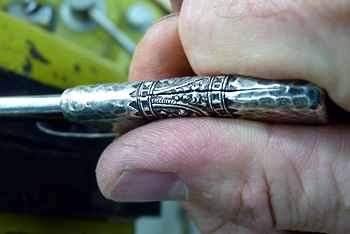
|
I'm wearing a 2.5-power magnifier from this
point on in the safe's restoration process. Here
I'm raising the seam with the burnisher past its
normal state, opening the joint for greater
access when I scrape the seam walls.
|
This modified dental tool has a narrow
triangular scraper on its end. It is used to
remove all solder in the joint so the filler
wire will be welded to the clean sterling. Pulse
arc and laser technologies will not fuse
successfully to solder that previously melted.
The filler metal will combine with the existing
solder and produce a grainy alloy with a color
that doesn't match the surrounding material.
|
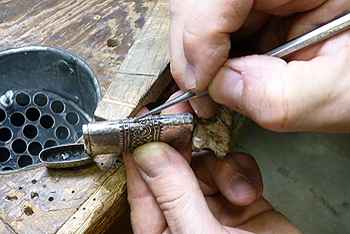
|
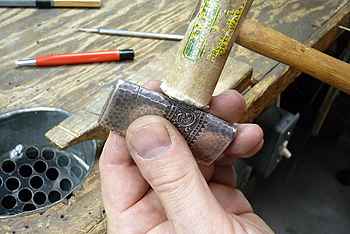
|
The joint is now tapped closed using a
rawhide mallet. The left and right side of the
seam are aligned to the same height. There still
exists a very slight taper from the bottom of
the seam to the top, which will enable me to
deposit sterling filler wire.
|
Here, a pulse arc welder is used to close
the seam. This technology allowed me to use
.005"-.010" diameter sterling wire on this
repair as opposed to brazing with hard silver
solder. Silver soldering would have taken much
longer: fluxing the piece to prevent firestain,
clean-up of the solder joint around the chased
detail, and extensive repatination. Pulse arc
welding localizes the heat and surrounds the
weld area with argon gas. This gas totally
eliminates oxides from forming in the sterling.
As you can see, the heat required to melt
sterling (1,640°F) is so localized, the safe can
be handheld!
|
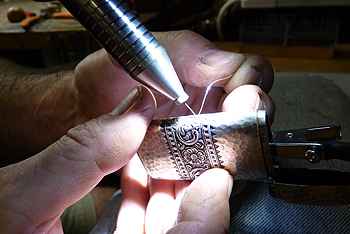
|
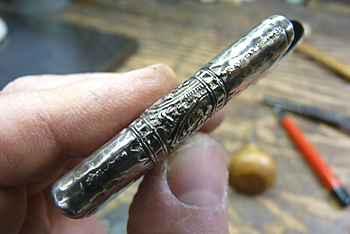
|
The joint after welding.
|
A rotary compactor is used to hammer down
and compress the sterling wire that was used for
the weld.
|
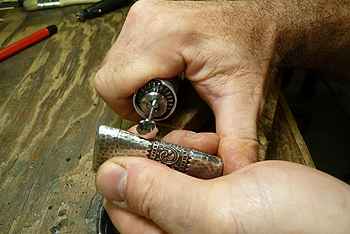
|
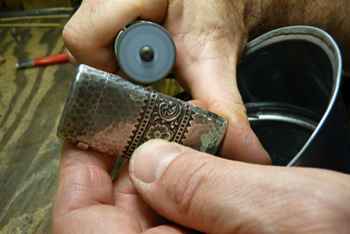
|
A fine rubberized abrasive wheel removes any
compactor imperfections.
|
A polished burnisher is then used to
redefine the chased planish marks and refine the
restored seam.
|
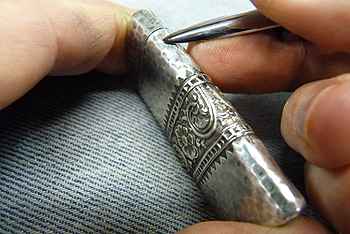
|
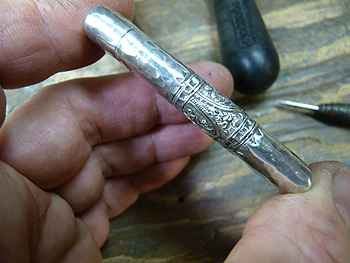
|
This is the result before repatinating.
|
A patina that will match the existing patina
is applied.
|
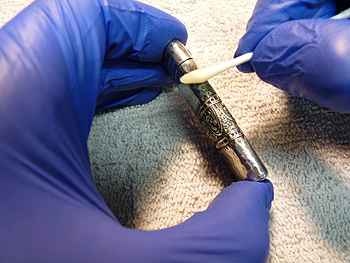
|
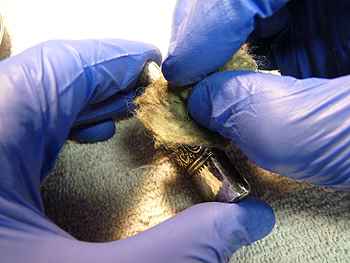
|
Wadding is finally used to remove any
unwanted patina and to produce a soft antique
finish. The match safe is then degreased and
wiped with a lint-free Selvyt cloth.
|

|
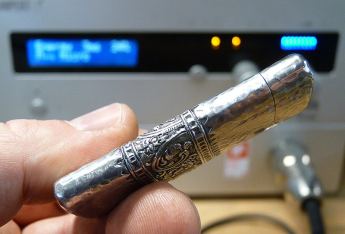
|
Before
|
After
|
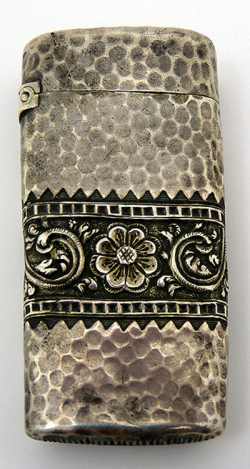
|
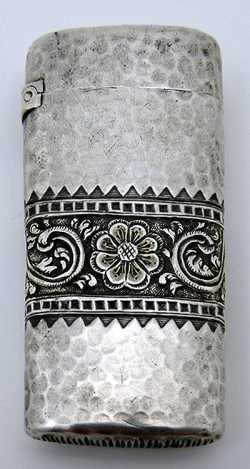
|
Before
|
After
|
Jeffrey Herman
- 2012 -
|
Jeffrey Herman worked at Gorham as designer,
sample maker, and technical illustrator. Upon
leaving Gorham, he took a position at Pilz Ltd where
he learned the fine art of restoration, and
fabricated mass-produced ecclesiastical ware. He
earned a BFA degree in silversmithing and jewelry
making from Maine College of Art in Portland,
studying under Harold Schremmer and Ernest Thompson,
two outstanding designer/craftsmen. He started his
business in 1984 gaining a national reputation of
quality craftsmanship repairing and reconstructing
everything, from historical pieces to single spoons.
He is the founder of the Society of American
Silversmiths.
Further details about Jeffrey Herman and information
contact are available in his website at
http://www.hermansilver.com
|
|
|

